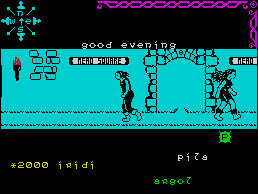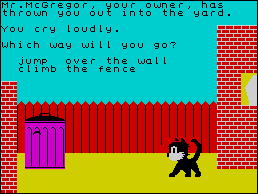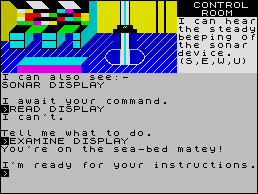| Adventure |

Richard Price has fun in Dun Darach and escapes from a sunk submarine
ANYONE who has done some hitch-hiking or long distance travelling will know how it feels to arrive somewhere new and foreign - tired, broke, edgy and with nowhere to stay. It is always unsettling and frustrating not to know, the local customs or how the natives will react to your outlandish behaviour and dress. It is ten times worse if you have no idea how you can raise some cash to survive a little bit longer.
If you have never experienced this first-hand you can still get a strong flavour of being on the road from Dun Darach - more a prequel than a sequel to Gargoyle's stunning Tir Na Nog.
|
Cuchulainn, Irish myth-hero, remains the central character in the new game. This time it is not the sidhe-ridden afterworld he strides through but a city of living men, more medieval than mystic with its winding, maze-like streets and busy, preoccupied citizens.

After a hard day's fighting against his traditional enemies, the men of Connacht, Cuchulainn and his charioteer Loeg stop at a wayside inn for the heroic equivalent of a long cool pint of JC.
As they wait for their drinks in comes a very beautiful woman, asking if one of them will help her with the broken axle of her carriage. Loeg is severely smitten and leaps to her assistance.
When Cuchulainn comes out to watch he finds that one of his chariot-horses has been slaughtered and his charioteer kidnapped. Further enquiries reveal that Loeg has been abducted by Skar, a good-looking but entirely evil sorceress whose base is the Secret City of Dun Darach.
Dun Darach uses the same outstanding graphic format as its predecessor and is effectively a controllable animated cartoon. Cuchulainn and the scene around him can be viewed from different angles and he can be moved left and right through the streets. He can enter houses, examine their interiors and collect objects. All actions are carried out by single key presses, with no text input.

The upper part of the screen shows the action with the remainder of the screen containing the compass indicator, list of possessions and the name of the quarter of the town you are moving through. Make no mistake, the city is large and bafflingly complex - although the streets are named, a map is essential.
You will find tradesmen of all kinds, private houses, temples, banks, gambling hells, police-like yeomen, pickpockets and honest citizens though there don't seem to be too many of those. It is possible to get a job or make money by stealing your self - that is difficult as the yoemen are vigilant and you will need to find an Arthur Daley figure to fence the goods before you get caught.
Gargoyle admits its debt to the works of fantasy writers like Fritz Lieber and Michael Moorcock. The company has created a city which is alive and fascinatingly complex and you will find it all too easy to neglect your true quest in favour of exploring and hustling.
The game is less abstract than Tir Na Nog - though there are plenty of enigmas to solve - and identification with Cuchulainn is easy as you wander the sleazy pleasure quarter of Iomain or the warrens of the Dispossessed.
I enjoyed every compulsive minute of Dun Darach. It is definitely not a rehash of a successful format, though it has the same technical excellence and careful programming. If anything it is a lot more interesting and eventful than the earlier game, with equally superb graphics. Get it as soon as you can and let me know quickly where I can sell a fat black pearl or stash some stolen gold bars. Absolutely recommended.
|
Caesar, the cheeky Daily Mirror cartoon cat, has appeared once before in a mouse-catching arcade game. Now he is the star of Caesar's Travels, described by the publishers as an animated story program and intended to attract the three to nine age group.
The hand-outs with the program make great play of the educational benefits of the game and so it seems fair to look at it as an aid to learning.

The game is basically an option adventure with the animated figure of Caesar walking through various scenes looking for a new home - he has been kicked out by his disgruntled owner Mr McGregor for smashing too much crockery in his pursuit of mice.
Each location is a full screen picture with text written above. There are six main options but no more than two appear on each screen. You may decide, for instance, to jump over a wall or hide in a dustbin.
There are 38 routes through the game and 18 different endings, all happy and non-violent - a point in the game's favour.
The graphics are bright and cheerful, very similar to the style of the earlier arcade game. However, Caesar flickers as he moves and the attributes tend to clash. Despite that, the cat is an appealing figure for children.
I am not sure that Caesar's Travels is successful as an educational tool as there are a number of inconsistencies which may only serve to confuse younger children.
At one point Caesar is disturbed in the night by a posse of alley cats. The player is asked to count the cats in the picture, but the other cats are depicted only as pairs of eyes glowing in the night. Even if you work out that those are the enemy cats you are not allowed to count Caesar who is the only really visible cat. Here then, you are expected to look through Caesar's eyes.
In contrast, at another decision point, you are given the option of going left or right. If you try to do this from the cat's viewpoint you will be told you are wrong.
|
Artic's adventures have tended to follow a style which is straightforward and without frills. Apart from the addition of graphics, the last adventure Eye of Bain was very much in the same vein and none the worse for it.
When I received a pre-production version of Dead at the Controls, I expected to find a tight but competent text game with added graphics. After an hour or so of play I found myself pretty disappointed.
You are the captain of a spaceship which explodes over a strange new planet. Heroically leaving the crew to their fate you parachute to earth to discover some means of escape.
Wandering through the jungle, you find a teleport device in an Aztec city - hang on, what's this about Aztecs, aren't we supposed to be on a strange new world? Oh well ... The teleporter will take you to several unrelated locations where you should be able to collect the various bits of a spacesuit. That's about it.
Despite fast, attractive graphics some repeated several times for different locations - the game lacks atmosphere. Anything which is not directly relevant to the solution has no real existence - examining things like rock cairns inevitably results in the response, 'You don't see much'. The world offers no opportunity for diversion and ends up as a bleak, unstimulating environment. The descriptions are minimal.
If the review version of Dead at the Controls resembles the final production copies then, sadly, the game is nowhere near Artic's usual standard.
|
This month's final offerings are both produced by Firebird and written with the Quill. The first is Subsunk.

You are Ed Lines ace reporter for the trade rag Seafaring Gazette. Your assignment, to seek out the truth of life in a nuclear submarine, has run into deep trouble. A foreign power has attacked the sub, captured the crew and scuttled the vessel.
Your only way to safety will be to rig up some sort of aerial and send a distress message to Headquarters.
There are fast, bright graphics for many of the sub's numerous compartments, the occasional sound effect, and a friendly interpreter which gives information about even useless items. Add a few wry jokes and you have an enjoyable adventure.
You have to devise a way not only to sort out the radio link but also to send up the aerial on a float. One slip and you will depressurise.
I was initially put off on reading the cassette notes and thought I was in for another dose of rather dreary escaping. Not so, as the sub is interesting enough to take your mind off the lack of other creatures. Well designed and thoroughly enjoyable escapism.
|
The Helm confers immortality on its wearers. The current owner is the local, evil Lich but he does not have all the pieces of the sacred headgear. Without all the bits he cannot become an eternal Lich so it is up to you to find the remaining disguised portions and enter the wicked one's castle. There you can steal the final piece. The Lich will not take kindly to this.
The game is text only and composed in medieval script which is occasionally difficult to read. The interpreter's responses are servile and sometimes long-winded - instead of 'What next?' you get 'What would you have me do next, Your Brillianceness?'.
The text scrolls up the screen in different colours and has a startling kaleidoscopic effect. Despite that the descriptions and general information are quite full and there is a fine tongue-in-cheek approach to the business of magical adventure.
There is a wide range of deduction problems ranging from the traditional crossing of the ravine to defeating a mesmerising Psyak - which manifests itself as a ball of light.
As far as I am concerned, Firebird can carry on bringing out programs like these. They both show that text adventures can be fun without having to be self-important in attitude.
|